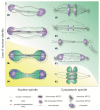Mixing and matching nuclear envelope remodeling and spindle assembly strategies in the evolution of mitosis
- PMID: 27062548
- PMCID: PMC7100904
- DOI: 10.1016/j.ceb.2016.03.016
Mixing and matching nuclear envelope remodeling and spindle assembly strategies in the evolution of mitosis
Abstract
In eukaryotes, cellular genome is enclosed inside a membrane-bound organelle called the nucleus. The nucleus compartmentalizes genome replication, repair and expression, keeping these activities separated from protein synthesis and other metabolic processes. Each proliferative division, the duplicated chromosomes must be equipartitioned between the daughter cells and this requires precise coordination between assembly of the microtubule-based mitotic spindle and nuclear remodeling. Here we review a surprising variety of strategies used by modern eukaryotes to manage these processes and discuss possible mechanisms that might have led to the emergence of this diversity in evolution.
Copyright © 2016 Elsevier Ltd. All rights reserved.
Figures


References
-
- Mans BJ, Anantharaman V, Aravind L, Koonin EV. Comparative genomics, evolution and origins of the nuclear envelope and nuclear pore complex. Cell cycle. 2004;3:1612–1637. - PubMed
-
- Amendola M, van Steensel B. Mechanisms and dynamics of nuclear lamina-genome interactions. Current opinion in cell biology. 2014;28:61–68. - PubMed
Publication types
MeSH terms
Grants and funding
LinkOut - more resources
Full Text Sources
Other Literature Sources

